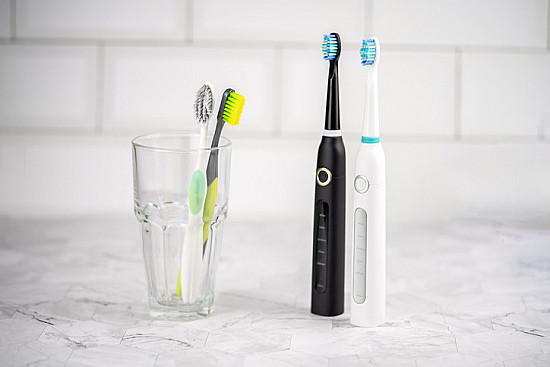[ad_1]

Having your teeth cleaned by a professional feels like a dental health reset. Your teeth are scrubbed, scraped and polished to perfection. Whether they stay that way is up to you. What happens at home (think Vegas rules) can be very different from what happens at the dentist. But don’t grit your teeth yet. Check out these three tips to boost your toothbrushing game and improve your health at the same time.
1. Understand incentives.
Every time you eat or drink something, bits of food or residue can cling to your teeth and gums. The debris and its bacteria turn into a sticky film called plaque. If you leave it on your teeth for too long, it calcifies. Hardened plaque is called tartar and cannot be removed with a toothbrush.
“Inside tartar are bacteria that release acids that cause cavities, break down your enamel and tunnel inside the tooth to the nerve and jaw bone, causing infection if they If left untreated, bacteria can travel to other parts of your body, including the brain, heart and lungs,” says Dr. Tien Jiang, prosthodontist at the Department of Oral Health Policy. And in Epidemiology from the Harvard School of Dental Medicine.
Bacteria linked to plaque can also irritate and infect the gumswhich damages gum tissue, the ligaments that hold teeth in place, and the jaw bone — leading to tooth loss.
Knowing all this, it is perhaps not surprising that poor dental health is associated with health problems such as high blood pressure, heart problems, diabetes, rheumatoid arthritis, osteoporosis, Alzheimer’s disease and pneumonia.
2. Select a good toothbrush.
A dizzying variety of toothbrush options range from simple plastic sticks with bristles to high-tech tools with bristles that spin or vibrate. But guess what: “It’s not the toothbrush that matters, it’s the technique,” says Dr. Jiang. “You may have a brush that does all the work for you. But if you don’t have excellent brushing technique, you’ll miss plaque, even with an electric toothbrush.”
So be wary of fanciful marketing claims that suggest one toothbrush is better than another. Instead, she recommends:
- Get a toothbrush that you love and will use regularly.
- Choose bristles based on the health of your gums. “If your gums are sensitive, you’ll need soft bristles that won’t cause irritation. If you don’t have gum problems, you can use hard bristles,” says Dr. Jiang.
- Replace your toothbrush every few months. “It’s time to change your brush if the bristles are flared and no longer straight, or if your teeth don’t seem clean after brushing,” says Dr. Jiang.
What if you want an electric toothbrush because holding a brush or brushing your teeth with good technique is difficult for you, or if you just enjoy the gadgetry and fun appeal of a brush? -tech?
Dr. Jiang says that’s no big deal, either — whether it’s a sleek device with a timer, pressure sensors, Bluetooth connectivity, and apps to guide you through the process. long brushing (prices range from $40 to $400) or a basic battery-operated gadget (prices start at $5). “Just try testing the settings to see if you’re comfortable with them, and bring the toothbrush to the teeth cleaning if you have questions about how to use it,” she says.
3. Use correct brushing technique.
Regardless of what type of toothbrush you use, Dr. Jiang suggests using this method of brushing twice a day and flossing before or after each time:
- Brush with fluoridated toothpaste for two minutes. Divide the time between the upper left, upper right, lower left and lower right teeth – 30 seconds per section.
- Tilt the brush. “The bristles should be directed toward the gums, where they meet the teeth, a junction where plaque and tartar accumulate. You don’t want the bristles to be perpendicular to your teeth, at a 90-degree angle, but inclined, at an angle of 45”. -degrees,” says Dr. Jiang.
- Make circles with the hairs. “Rotate the bristles in a gentle sweeping motion to help catch debris at the gum line,” says Dr. Jiang.
- Brush without distractions so you can focus on your brushing technique.
- Be gentle. If you press too hard while brushing, you risk irritating and possibly hurting your gums. Also brush your tongue. It collects many bacteria that need to be eliminated.
- Rinse your mouth and your brush. Wash away any traces of toothpaste and food debris.
- Take a look at your gums. When you’re finished brushing your teeth, pull your lips away from your teeth to see if you’ve left any food particles around your teeth. Your gums should not appear red or swollen.
Not sure if you’re brushing your teeth the right way? Dr. Jiang suggests practicing without toothpaste. When you rub your tongue against your teeth, everything should feel smooth.
See a dental hygienist for cleanings every six months and your dentist at least once a year, even if these visits make you anxious. And if you notice any problems between visits, call the dental team. But remember: a lot of the work it takes to keep your teeth clean comes from good habits at homenot the dentist’s office.
[ad_2]
Source link
